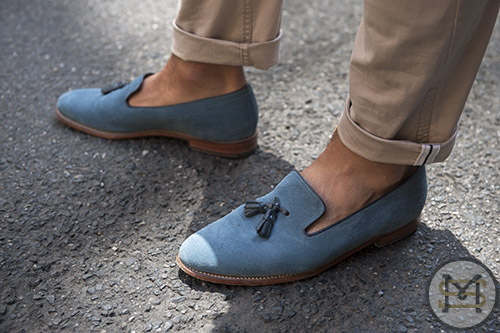Interview: Michael Albert, Smart Alec Hatters
“Hats for me are the completion of an outfit. When everything is considered then it becomes the full-stop at the end of a great sentence.”
- Michael Albert
Two things become fast apparent during a face-to-face meeting with Michael Albert, owner of premier hat store, Smart Alec, on Fitzroy’s Gertrude Street.
Firstly, the man has style, from the tips of today’s red Converse clad toes to the brim of his self-made pork pie hat. And secondly? The self-described “serial dandy” (“I have 30 vintage suits and can go for a whole month without wearing the same shirt twice”) is relentless in his quest to see men leave behind teenage fashion trends and reclaim a complete approach to dressing well.
Michael: “For me introducing men to hats is about championing the cause of a forgotten accessory. I see gentlemen in the street and, no matter how well they are dressed, if there is no hat then I just see something missing.
He has no hesitation in calling out lazy fashion choices, having a stern word to men for dressing as boys, and recalling the horror of his partner at over-hearing recent comments he directed toward a baseball cap-wearing browser.
Michael: “I said, ‘You don’t live in a caravan, you’ve got all your teeth – what do you wear a baseball cap for?’ And his wife agreed!”
The one-time artist and builder (“I have made things nearly all my adult life”) stocks head candy from around 10 different manufacturers, though prefers to make the glamorous specials himself: think pirate hats or the traditional fez, smaller run, presumable harder to sell pieces that speak to his more adventurous clientele.
Because for Michael, style is about much more than looking good: it’s about power, reclamation and maintaining an edge against those that would hold you down.
Michael: “As a brown fells in Australia I have used my style to disarm people – they can’t pigeon-hole you and that is to your advantage. And I’d like to think that young and old men are rediscovering that a nice suit is your friend, not an instrument of oppression in the way it was used when I went to a private boys school.”
And, if nothing else, a great hat just might increase your chances with the ladies.
Michael: “I had a lovely Indian man in his 60s come in. He bought a hat, went for a coffee and came back to tell me that the pretty young French waitress said he was perfectly coordinated.”
Not a bad return on investment.
235 Gertrude Street, Fitzroy.
ph: (03) 9416 4664
e: info@smartalechatters.com.au






























